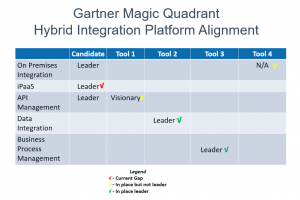In this article we will examine the rationale and steps to assess your integration architecture using industry analysts’ perspectives.
If you question the need for a robust integration architecture, consider that both Gartner and Forrester stress integration as critical to a digital transformation and the running of a digital business. According to the Gartner report “Building a Digital Business Technology Platform”, a digital business is supported by a technology platform in five areas:
1. Information systems platform
2. Customer experience platform
3. Data and analytics platform
4. Internet of Things (IoT) platform
5. Ecosystems platform
In the report, Gartner says the ecosystems platform “supports the creation of, and connection to, external ecosystems, marketplaces and communities. API management, control and security are its main elements.” So from Gartner’s perspective, API management is a key component of the digital technology platform, the platform used to build and run your digital business.
In the Forrester paper “Predictions 2017: In Digital Transformation, The Hard Work Of Operational Excellence Begins”, they make the case that a shift in the digital transformation to operational excellence has just begun saying, “under the threat of digital disrupters, you must lead your fellow executives to a deeper understanding of the potential of technology to also transform your operating model to further enhance your digital products, services, and customer engagement.” And with regard to integration, that “APIs are your new shop window, so treat them like a business product.” APIs are required to digitize your products and business processes.
Gartner and Forrester make specific recommendations for APIs as a key part of a digital business strategy and architecture. Gartner saying that API management should be part of the digital platform used to deliver the digital business strategy. And, Forrester making the recommendation to manage APIs as products. Also, improved application integration, data quality and analytics, and business process management will be required for Forrester’s predicted shift of digital transformation to improvements in business operational excellence.
In the report “CIO Call to Action: Shake Up Your Integration Strategy to Enable Digital Transformation” Gartner says, “Most CIOs have yet to recognize that their traditional, established integration strategy cannot cope with digitization’s fast technology innovation and accelerated pace of business.” Data volumes and the number of end-points to integrate are expanding rapidly with cloud computing, mobile devices and the Internet of Things (IoT). If you have not updated your integration strategy and architecture lately, there are likely gaps in the areas of API management and cloud integration.
For cloud native integration, Gartner introduced the term Integration Platform as a Service (iPaaS) as “a suite of cloud services enabling development, execution and governance of integration flows connecting any combination of on premises and cloud-based processes, services, applications and data within individual or across multiple organizations”. iPaaS integration tools speed SaaS integrations, for example by offering a Salesforce.com connector, and enables do-it-yourself (DIY) integration. DIY integration allows non-technical users to access SaaS data and do simple integrations with on-premises systems. DIY integrators and APIs greatly expands the staff that can do integrations within a company, which significantly improves the pace of integration.
Gartner says, “API management is about the planning, design, implementation, publication, operation, consumption, maintenance and retirement of APIs. It includes a developer’s portal to target, assist and govern the communities of developers who embed the APIs, as well as the runtime management and analytics.” API management is a key architecture component to manage APIs as products and to open your digital business to an ecosystem of developers, partners and customers.
Perficient is often called upon to assess companies’ integration platforms and it is most often the gaps are around iPaaS integration and API management – not surprising since these are the most modern developments in the space. API management is needed to productize APIs and to create your company’s digital ecosystem. iPaaS is needed to enable DIY integrators and quickly modernize IT systems by adopting SaaS applications.
To best understand how iPaaS and API management fit, think of integration architecture holistically as a set of tools to integrate on-premises applications, cloud applications, data and business processes. Gartner says, “leading-edge organizations have moved toward a hybrid integration platform (HIP) that combines on-premises (for example, ESBs or ETL) and cloud platforms (for example, iPaaS or API management), but mainstream users have not yet absorbed the relevant best practices.”
Using this HIP concept as a reference architecture for integration, you can assess the gaps in your integration architecture with an inventory and categorization of the integration tools in house. The integration tools can be mapped to the following categories:
• On-premises integration (e.g. ESBs)
• iPaaS (native cloud integration)
• API management
• Data integration (e.g. ETL and MDM)
• Business process management (e.g. process modeling, workflow, case management)
Once you have the tools categorized, the gaps will be evident and simply mapping them to industry rankings, such as Gartner’s Magic Quadrant, will show if you are running best-in-class tools. You can also introduce candidate products to show how these gaps can be filled noting that some products can fill multiple gaps – e.g. both on-premises and native cloud integration as deployment options.
When you understand your integration gaps you can look to build a business case to fill those gaps, gather integration requirements and select the right software for your needs. Perficient has several blogs on these topics as well, for example getting started with iPaaS integration.

